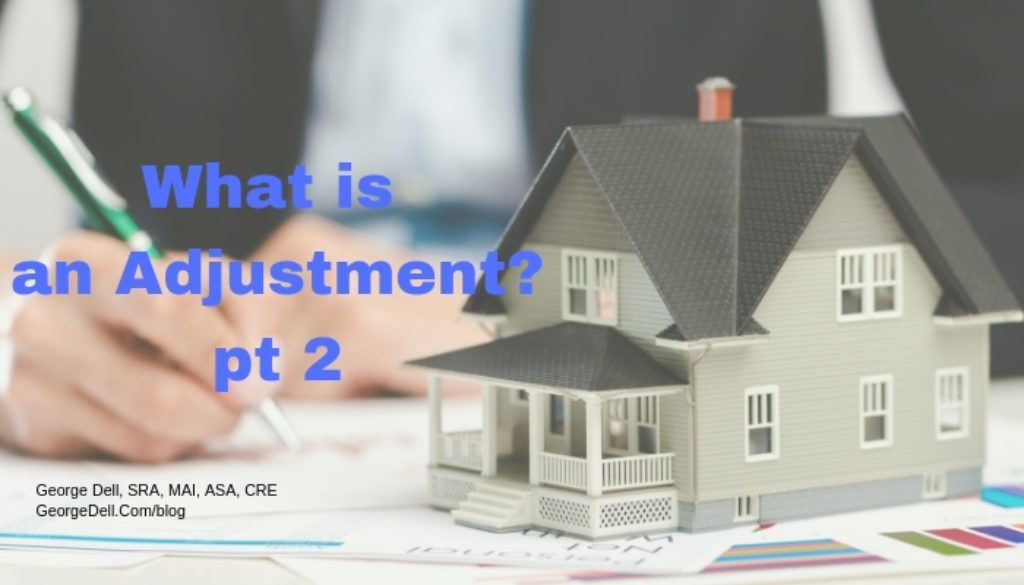What is an adjustment?
In a prior blog, we noted that no one seems to really know! We looked at the AI Dictionary of Real Estate Appraisal. We looked at The Appraisal of Real Estate (TARE). And we looked at the “Uniform” standards. All these sources tell us that adjustments are important and should be made. “Derive” adjustments, “prove” adjustments, “refine” adjustments, “specific” adjustments, “adjustment grids,” “market-supported” adjustments, “making” adjustments, the “adjustment process,” “reveal” adjustments, “appropriately developed” adjustments, “required” adjustments.
Each time we try to figure out what it is we are supposed to do, it gets deeper and muckier.
The Fannie Mae and Freddie Mac “form algorithm” even says that for some adjustments (such as financing or concessions) “the dollar amount of any adjustment should approximate the market’s reaction to the financing or concessions based on the appraiser’s judgment.
The magnitude of each adjustment is indicated by the data and the judgment of the appraiser. (Emphases added). TARE p. 367. Finally, p. 398 says: “In applying quantitative adjustments, qualitative analysis, or both, appraisers must ensure that their reasoning is clear and adequately explained in the appraisal report. TARE p. 46 even admits that some “quantitative adjustments cannot be developed.”
So, there you have it. It is all about your thinking, your judgment, your reasoning, and ability to explain your thoughts. Surely, we must have something better! Well, TARE (p. 398) tries. It gives us four techniques to quantify adjustments:
- Data analysis;
- Statistical analysis;
- Cost-related, and
- Income differences.
All would be well, except that the next several pages go on to apologize. We see statements such as:
“Paired data analysis should be developed with extreme care…”
“Although paired data analysis of sales or rents is a theoretically sound method, it may be impractical and produce unreliable results.”
“Special care must be taken when relying on pairs of adjusted prices…”
And “secondary data analysis … makes use of data that does not directly pertain to the subject or comparable properties” … “and may need verification.”
“In applying statistical analysis, the appraiser must be careful not to develop a result that is
mathematically precise yet logically meaningless or inappropriate…”
But is there a solution?
“Statistical methods may also be applied to calculate adjustments to comparable sales. To use any form of statistical analysis, the appraiser must understand (and properly apply) fundamental statistical concepts as well as the particular methodology selected.
Herein lies the problem. While we are told that basic (fundamental) statistics are what is important—we are referred to what is called “advanced statistical applications.” (What ever happened to beginning and intermediate?)
So, what is the real solution? For the real solution involves we must confess:
- There is never a correct or exact amount;
- What counts is how good is the estimate.
In coming blogs, (in depth and in advance to TAAR subscribers) we will consider what really matters. We will consider the three algorithmic types of adjustments: 1) deterministic; 2) estimated; and 3) asymptotic (that ‘nuzzle up’ to the true answer).
Some adjustments can in fact provide “exact, single point” numbers. Others can only be estimated, so what is important is to know the reliability or sureness of the adjustment amount. Finally, some adjustments we know are wrong. Biased in some direction. But they may still be useful!
The ‘statistics’ are actually simple. What is important is the modeling. What is important is getting the data right in the first place. Knowing your market. Knowing what to look for. And knowing how to communicate the trueness and sureness of your results to your client.
All models are wrong, some are useful.
George Box, Journal of the American Statistical Association, 1976.
Appraiser analyst judgment is essential to using useful models. Modeling is the future of valuation and asset analytics. The statistics are simple. Your phone can do it.

May 3, 2019 @ 2:30 am
I like the way you think. I am almost always sure of the direction of the adjustment, and always concerned about the magnitude of the adjustment.
For this reason I make large adjustments for major items, up or down, few if any for minor factors
It is silly to see $1,000 adjustments on a million-dollar property. And yet I continue to see them with no support other than empty statements.
August 9, 2019 @ 7:38 am
I use many statements in my reports that attempt to address things that have bothered me for years…..such as the general inability of any appraiser to confirm or verify the features and conditions of a “comparable sale” beyond MLS data and confirmation from a party directly related to the production of a commission. So statements like: “The apparent and observed features and conditions of the subject property are matched or bracketed by those properties deemed comparable within the search parameters stated in this report after market supported adjustment to reconcile those apparent differences for which market reaction exists and is reasonably verifiable. Notably, appraisal standards require such adjustments to reconcile differences, while at the same time prohibit such adjustments when there is no verifiable market reaction support” are common in my reports. Now, I know that not 1 in 100 clients or reviewers ever read or understand such a statement, and it has yet to be tested in court or arbitration, but having dozens of statements just like that filtered into each and every report I produce….. gives me a comfort level as my job description creeps into being an underwriter, home inspector, plumbing expert, zoning guru, permit diagnostic engineer, water heater installation specialist, and so on. Steve… if anyone out there can demonstrate support for a $1000 adjustment on a million dollar property…. or ANY property for that matter (unless the adjustment is merely cosmetic to avoid misleading the client by omission), I would suggest they have missed their calling. God, grant me the serenity……….